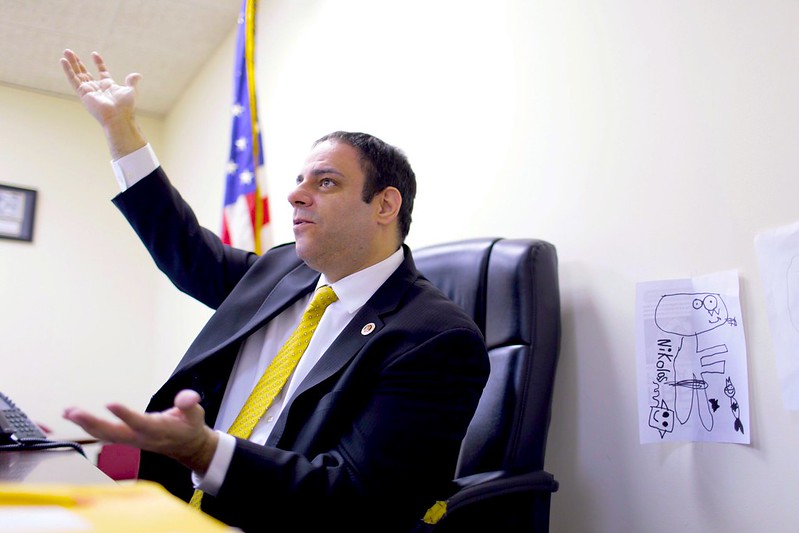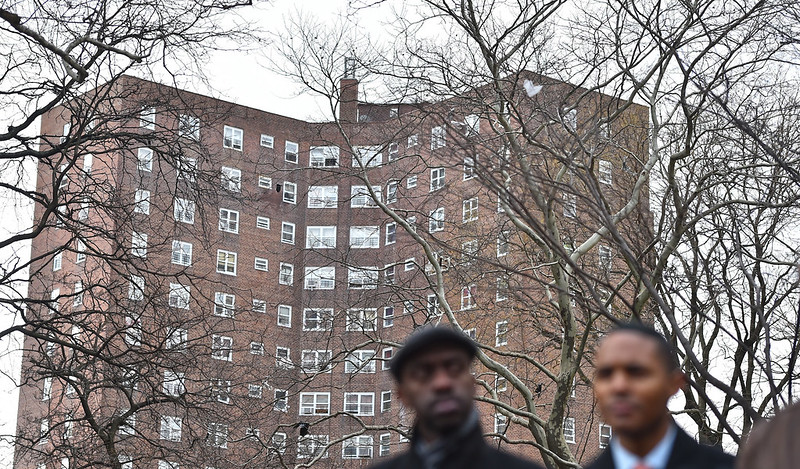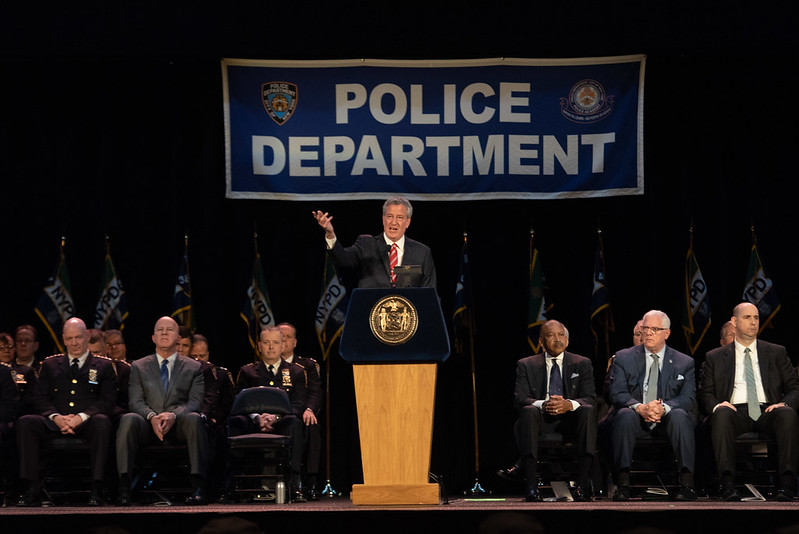I Survived COVID-19; It Proved the Queens Hospital Crisis

Council Member Costa Constantinides (photo: New York City Council)
The whole thing happened so fast. One minute my son and I are playing video games and the next he and my wife, who struggles with diabetes and is in renal failure, rush out the door to her mother’s apartment. So much has changed for my family and our community in the weeks since my fever first hit 102 degrees. However, throughout this experience, one thing remains shockingly clear: we need more hospitals in Queens and to reimagine how people access health care in the World’s Borough.
Queens is the epicenter of the epicenter. All of us — from those who fell ill, to our healthcare workers, to those whose anxiety was worsened by being locked in for weeks — will no doubt carry physical and mental scars forever. My family’s hellish few weeks of multiple trips to the hospital is the story of so many residents of Queens, where well over 56,000 positive cases are among the most of any county in New York State. And in many ways my wife and I are lucky.
Still, I’ll admit it’s been hard not to be angry at the fact that Queens has lost five hospitals over the last 20 years. You cannot refute that the loss of hundreds of hospital beds over a two-year period in the late 2000s is part of the reason why so many people have died — many at home surrounded by panicked relatives unsure of what to do. About one-sixth of all New York State’s positive COVID-19 cases have been in Queens, a borough of 2.3 million people serviced by eight hospitals. It doesn’t take a math expert to see this was a doomed situation from the get-go. Because we didn’t have a plan sooner to flatter the curve, a tidal wave crashed down on our already worn-out health-care system -- and we couldn’t even brace for it.
This virus is an enigma even the world’s most brilliant minds are still working to crack. Not understanding the symptoms has led many of us to overthink every cough. Panic reigned supreme. Was I cold because the fever is back or because the window was open? Do I have to go to the hospital for burning my hand on the radiator, potentially spreading this to more people? Why did I feel better one day and twice as worse the next? It took weeks to accept the fact that I cannot unpack this problem, determine the cause, and find a creative solution. I could not legislate away the coronavirus.
The best I can do is to get better, then work like hell to make sure other people can solve this. Once we’re fully on the other side of this curve the first order of business must be to build new hospitals in Queens. We lacked the capacity to properly observe all COVID-19 patients, let alone treat any other illnesses or injuries people experienced during the apex. The isolation of this virus is the cruelest part, as it takes away the support system on which we all rely. Many sat at home like I did, frightened by their symptoms, left to stare at their son’s toys on the floor or their wedding photo on the wall and wonder, Will I ever see my family again?
New hospitals shouldn’t be just about saving the lives of people who walk into them. It’s about those who run them, too. Our health-care workers are heroes, but they’ve also borne the burden of a pared down medical system. They work tiring shifts without enough protective equipment. Because we cannot hold our loved ones’ hands as they succumb to this virus, these heroes provide those last moments of comfort. Many are stoics who shrug it off as “part of the job,” but we know they are silently fighting severe emotional distress. A memorial to them is overdue. But the greatest tribute we can make is to build the infrastructure, both in more capacity so they can do their best job possible the next time a pandemic strikes and in support so they won’t be coming home to deal with tragedy alone.
I first ran for office seven years ago on the promise to support Mount Sinai Queens, which in 2004 didn’t have the specialized resources to treat my father for an aneurysm. He died in transit to the closest Manhattan hospital that could. My hope was that no one would have to face the choice I did: let him die here in Queens or run the risk of crossing the bridge. I thought it was a major victory when we funded a state-of-the-art stroke center there. I've been proud to support and partner on this vision of growth at Mt. Sinai. In hindsight, however, it was a drop in the bucket. So much more is needed now.
Everyone should have the ability to go to a hospital. The hard work to get out of this crisis has only begun. It will be all for nothing unless we fight for greater hospital capacity. I owe it to the countless people who made sure our son still has his mom and dad.
***
Costa Constantinides is a New York City Council Member and candidate for Queens Borough President. On Twitter @Costa4NY.
***
Have an op-ed idea or submission for Gotham Gazette? Email This email address is being protected from spambots. You need JavaScript enabled to view it.
NYCHA in the Time of COVID-19 and Beyond

A NYCHA tower looms over a city in crisis (photo: Kevin P. Coughlin/Governor's Office)
In late April, Mayor de Blasio announced a plan to deepen the city’s response to COVID-19 at NYCHA public housing. The plan includes distributing face coverings and gloves to all residents, enrolling all NYCHA senior buildings in the city’s food delivery program, and providing free tablets and internet service for 10,000 senior residents.
It’s long been clear that issues at NYCHA are pervasive, including disgraceful mismanagement of public money and the authority’s crippled system of communication with tenants, which is now more fully showing its limitations. Several weeks after de Blasio’s announcement, NYCHA residents throughout the city were still waiting for components of the plan aimed to support them in this new reality.
NYCHA resident leaders in the South Bronx, for example, have verified that since the hiring of outside contractors they have seen an overall increase in sterilization of their development, however touchpoints like elevators, mailboxes, and door-knobs are not sterilized on a regular basis.
NYCHA’s 2,200 buildings, like the public transit system, senior centers, and other often crowded areas, are potential virus hotspots. It is unacceptable that we do not have widespread testing at NYCHA developments -- an intentional effort by the city is past due.
COVID-19 has hit poor communities, black and brown folks, the hardest across our city. In a post-shutdown city, NYCHA residents must have comprehensive protections against both the virus and the ever-present epidemic of decades-long disregard and disinvestment. NYCHA residents must be afforded ample opportunity for testing and isolation when needed.
According to the Centers for Disease Control, some of the risk factors associated with COVID-19 are age (65 years or older) and conditions including chronic lung disease or moderate to severe asthma. NYCHA tenants regularly report asthma issues and cockroaches, which are an allergen source and an asthma trigger. NYCHA, which has not released a strategy for tracking COVID-19 infection rates, has left residents, building staff, and advocates to highlight the extent of the crisis.
The Housing Authority has bragged about posting updates to their website and social media accounts; sending out emails and alerts through its MyNYCHAapp; posting multilingual fliers in common areas; and scheduling robocalls and in-person outreach. In mid-March, NYCHA said it would start disinfecting its senior buildings five times a week, and all other buildings three times a week. NYCHA residents in East New York, Brownsville, and the South Bronx tell us they haven’t seen this happening with the care (and in some cases the frequency) the Authority has promised.
NYCHA has hired outside contractors to disinfect high-touch areas like elevators, but is still relying on its on-site caretakers to clean the rest of its buildings. The people responsible for keeping housing complexes clean, have themselves been sidelined by unsafe working conditions.
When it comes to the plan released by Mayor de Blasio, which promised PPE to all residents, among other precautions and protections, there has been a disjointed narrative and implementation, necessitating that NYCHA Tenant Association leaders across the city step up when the city has fallen short -- from handing out PPE to meals, NYCHA residents have exemplified a collective will.
Danny Barber, Chair of the Citywide Council of Presidents of NYCHA residents, in partnership with World Kitchen has delivered over 200,000 meals to NYCHA residents and has set a goal to deliver 1 million meals to NYCHA residents throughout the city.
NYCHA tenants in the South Bronx, East New York, Brownsville, and all across our entire city deserve housing that is safe, healthy, and secure. As the current lockdown ends, we will need to ensure that our NYCHA communities have all the resources that they need. A comprehensive post-shutdown NYCHA plan must include:
- COVID-19 testing sites at each NYCHA development
- Food pantry expansion to include a pantry at every NYCHA Community Center
- A NYCHA Residents’ Bill of Rights
- Free wifi for all NYCHA developments
- Development-specific emergency relief plans
- Hazard pay for NYCHA Tenant Associations
- Community-based-organization partnerships to ensure mental health effects of the pandemic are being addressed
Our vulnerabilities have been further exposed by COVID-19. We need to move away from a reactive society to a proactive society. Our leaders must have the political courage to plan for a future where the government both anticipates better and responds more aggressively and efficiently to emergencies, ensuring that our most vulnerable communities are not disproportionately impacted.
***
Wilfredo Florentino is a life-long Brooklynite, community advocate, community board member, and candidate for New York City Council in the 42nd District. Althea Stevens is a native New Yorker and community advocate in the Bronx and candidate for New York City Council 16th District. On Twitter @WilfredoBrooklyn & @Althea_s21.
***
Have an op-ed idea or submission for Gotham Gazette? Email This email address is being protected from spambots. You need JavaScript enabled to view it.
De Blasio’s Empty Words: The Mayor’s Long-Running Failure to Ensure Police Accountability

Mayor de Blasio and the NYPD (photo: Michael Appleton/Mayor's Office)
Earlier this week, after nearly six-and-a-half years in office and repeatedly failing to meaningfully and systematically hold his own police department accountable for brutalizing and killing black New Yorkers, Mayor de Blasio took to Twitter to express outrage about Minneapolis police officer Derek Chauvin’s murder of George Floyd.
De Blasio forcefully demanded swift action by authorities in a city half-way across the country. He then proceeded to fail completely to stop police brutality in his own city on Friday and Saturday nights, when black New Yorkers and allies took to the streets to demand justice for Floyd and an end to institutional racism. The NYPD deployed thousands of officers who immediately created a war-like environment and escalated matters, repeatedly initiating violence against community members.
It takes a particular kind of political and moral cowardice to call for justice a thousand miles away while failing to protect black and Latino communities from racist policing in his own city. Martin Luther King Jr. forewarned us about politicians like de Blasio, ”those more concerned with ‘order’ than justice.”
The killing of George Floyd was horrifyingly similar to the NYPD’s killing of Eric Garner. In broad daylight, a police officer choked the life out of a black man on a sidewalk. Cries for help went unheeded by the other officers on the scene.
For more than five years, de Blasio sat on his hands, avoiding any and all responsibility for pursuing discipline or accountability for all officers involved in Eric Garner’s killing. Now former officer Daniel Pantaleo, caught on video choking Garner to death, remained employed by the NYPD for more than five years, even collecting overtime. When the department’s trial revealed egregious misconduct by other officers present, the mayor did all he could to turn the page following the firing of only Pantaleo. Eric Garner’s mother, Gwen Carr, continues to organize and call for all of the officers responsible to be fired. The mayor continues to ignore her calls for accountability and justice.
The murder of Eric Garner is the most high-profile case, but by no means the only time de Blasio spectacularly failed to hold the NYPD accountable for brutalizing and killing black and Latino New Yorkers. Delrawn Small, Jazmine Headley, Saheed Vassell, Sergio Reyes, Kawasaki Trawick -- they may not be as well know as Eric Garner, but their stories are other glaring failures on the part of the mayor to ensure the NYPD is held accountable for brutality and murder. These are only the cases the public hears about. But officers escaping without any discipline for misconduct or brutality, even in cases where people are killed, is the norm not an anomaly.
More recently, during the COVID-19 pandemic, numerous videos of NYPD officers violently enforcing social distancing in black and Latino communities showed the type of violent and biased policing that leads to the deaths of community members like George Floyd, Breonna Taylor, Tony McDade, Eric Garner, Delrawn Small, Saheed Vassell, and many, many others. Police brutality doesn’t take a break for pandemics.
Black and Latino communities have not only suffered because our state and city governments failed to prepare for the disproportionate impact of COVID-19. Mayor de Blasio’s failed approach, where he proactively decided to criminalize a public health crisis before claiming to reverse course, has meant policing enforcement that continued to target our communities.
The mayor has spent much of the pandemic defending and downplaying the NYPD’s discriminatory and dangerous actions, even going as far as victim-blaming black New Yorkers for not following orders and cooperating. A recent video of police brutality during the pandemic shows what easily could have resulted in a similar tragic outcome to George Floyd’s or Eric Garner’s murder. Three weeks ago, following a violent take-down, NYPD officer Francisco Garcia sat on the head and neck of a prone Donni Wright. Wright luckily escaped with his life. De Blasio was much more tempered in his condemnation of the NYPD following that incident and refrained from any calls for swift consequences for the officers involved.
Friday’s night’s numerous incidents of police brutality made the problem even clearer, with officers running amok, beating, pushing, and pepper-spraying New Yorkers. Mayor de Blasio responded with a sad sort of “both sides-ism,” and nothing resembling a true commitment to firing abusive officers and holding the department accountable throughout the chain of command. On Saturday night, after new incidents of blatant policy brutality, the mayor even came to the defense of officers who had driven into protestors with an SUV.
As de Blasio’s second and final term comes to an end, he has cemented his legacy on policing. He was unwilling to hold the NYPD accountable for misconduct and brutality, failed to end “broken windows” policing, and chose to regurgitate talking points about training and neighborhood policing, rather than heeding the calls for justice and meaningful reform. If the mayor is serious about addressing police brutality and valuing all black lives, he should use the remainder of his time in office to pass and support strong legislative reforms to increase police accountability and transparency, while also taking sweeping executive action to change the department that he purportedly controls.
The Mayor should forcefully advocate for full repeal and not a watered down replacement of state Civil Rights Law 50-a in order to make public all police disciplinary records. He should ensure the NYPD swiftly terminates Officer Garcia, all of the officers involved in Eric Garner’s murder, and any officer who abuses their power, including in this week’s protests. And as the city gets closer to finalizing the fiscal year 2021 budget, the mayor should significantly reduce the NYPD budget and headcount and direct cost-savings towards the Department of Youth and Community Development, education, housing, housing the homeless, and social services that keep our communities safe and healthy.
The frustration and outrage manifested in this week’s protests are not merely in solidarity with communities in Minneapolis demanding justice for George Floyd. They are a response to the failure of Mayor de Blasio and decades of previous elected officials who have sanctioned daily state violence against black people in New York. They are the manifestation of generations of black people who have struggled to breathe with the weight of America’s anti-black racism on our necks. Almost six years after Eric Garner’s tragic murder at the hands of the NYPD, we still can’t breathe.
***
Kesi Foster is the Co-Director of the Youth Power Project at Make the Road New York. On Twitter: @BemKesi @MaketheRoadNY.
***
Have an op-ed idea or submission for Gotham Gazette? Email This email address is being protected from spambots. You need JavaScript enabled to view it.




